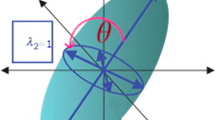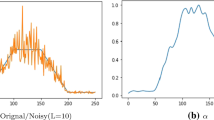Abstract
This paper treats the inverse denoising problem which aims to compute simultaneously the clean image and the weighting parameter \(\lambda \). The formulated denoising problem is posed using a partial differential equation (PDE)-constrained optimization model. The minimized function imposes a Tikhonov regularization on the estimated \(\lambda \), while the proposed PDE encompasses two high-order diffusive tensors. The particularity of this PDE is that it does not over-smooth homogeneous regions and preserves sharp edges during the denoising process, even if its degree is high. A new optimization procedure to compute the weighting parameter is also elaborated inspired from the nonsmooth Primal-dual algorithm. This leads to control of the diffusivity rate generated by the two diffusive operators. Finally, expressive results show that the computed spatial parameter \(\lambda \) leads to obtain a pleasant clean image. This is also confirmed by numerous comparisons with other competitive denoising approaches.












Similar content being viewed by others
References
Borcea, L., Kang, H., Liu, H., Uhlmann, G.: Inverse problems and imaging, Vol. 44 of Panoramas et Synthèses [Panoramas and Syntheses], Société Mathématique de France, Paris, 2015, lectures from the workshop held at the Institut Henri Poincaré, Paris, February 20–22 (2013), Edited by H. Ammari and J. Garnier
Kabanikhin, S.I.: Inverse and Ill-Posed Problems, Vol. 55 of Inverse and Ill-Posed Problems Series. Walter de Gruyter GmbH & Co. KG, Berlin (2012). theory and applications
Bergam, A., Chakib, A., Nachaoui, A., Nachaoui, M.: Adaptive mesh techniques based on a posteriori error estimates for an inverse Cauchy problem. Appl. Math. Comput. 346, 865–878 (2019)
Chakib, A., Nachaoui, A., Nachaoui, M.: Approximation and numerical realization of an optimal design welding problem. Numer. Methods Partial Differ. Equ. 29(5), 1563–1586 (2013)
Lyaqini, S., Quafafou, M., Nachaoui, M., Chakib, A.: Supervised learning as an inverse problem based on non-smooth loss function. Knowl. Inf. Syst. 62, 3039–3058 (2020)
Hadamard, J.: Lectures on Cauchy’s Problem in Linear Partial Differential Equations. Dover Publications, New York (1953)
Engl, H.W., Hanke, M., Neubauer, A.: Regularization of Inverse Problems, Vol. 375 of Mathematics and Its Applications. Kluwer Academic Publishers Group, Dordrecht (1996)
Hintermüller, M., Rautenberg, C.N., Wu, T., Langer, A.: Optimal selection of the regularization function in a weighted total variation model. part ii: Algorithm, its analysis and numerical tests. J. Math. Imaging Vis. 59(3), 515–533 (2017)
Berdawood, K.A., Nachaoui, A., Saeed, R., Nachaoui, M., Aboud, F.: An alternating procedure with dynamic relaxation for Cauchy problems governed by the modified Helmholtz equation. Adv. Math. Models Appl. 5(1), 131–139 (2020)
Nachaoui, A., Nachaoui, M., Chakib, A., Hilal, M.A.: Some novel numerical techniques for an inverse Cauchy problem. J. Comput. Appl. Math. 381, 113030, 21 (2021)
Afraites, L., Hadri, A., Laghrib, A.: A denoising model adapted for impulse and gaussian noises using a constrained-pde. Inverse Prob. 36(2), 025006 (2020)
Laghrib, A., Chakib, A., Hadri, A., Hakim, A.: A nonlinear fourth-order PDE for multi-frame image super-resolution enhancement. Discrete Cont. Dyn. Syst. B 25(1), 415 (2020)
Kallel, M., Moakher, M., Theljani, A.: The Cauchy problem for a nonlinear elliptic equation: Nash-game approach and application to image inpainting. Inverse Probl. Imaging 9(3), 853–874 (2015)
Coupe, P., Yger, P., Prima, S., Hellier, P., Kervrann, C., Barillot, C.: An optimized blockwise nonlocal means denoising filter for 3-D magnetic resonance images. IEEE Trans. Med. Imaging 27(4), 425–441 (2008)
Dasgupta, A., Chakraborty, S., Routray, A.: A two-stage framework for denoising electrooculography signals. Biomed. Signal Process. Control 31, 231–237 (2017)
Beckouche, S., Starck, J.-L., Fadili, J.: Astronomical image denoising using dictionary learning. Astron. Astrophys. 556, A132 (2013)
Bertero, M., Boccacci, P., Robberto, M.: Inversion of second-difference operators with application to infrared astronomy. Inverse Prob. 19(6), 1427 (2003)
Aubert, G., Aujol, J.-F.: A variational approach to removing multiplicative noise. SIAM J. Appl. Math. 68(4), 925–946 (2008)
Getreuer, P., Tong, M., Vese, L.A.: A variational model for the restoration of MR images corrupted by blur and Rician noise. In: International Symposium on Visual Computing, pp. 686–698 (2011)
Holler, G., Kunisch, K., Barnard, R.C.: A bilevel approach for parameter learning in inverse problems. Inverse Probl. 34(11), 115012, 28 (2018)
Kunisch, K., Pock, T.: A bilevel optimization approach for parameter learning in variational models. SIAM J. Imaging Sci. 6(2), 938–983 (2013)
Langer, A.: Automated parameter selection for total variation minimization in image restoration. J. Math. Imaging Vis. 57, 239–268 (2017)
Antil, H., Di, Z.W., Khatri, R.: Bilevel optimization, deep learning and fractional Laplacian regularization with applications in tomography. Inverse Probl. 36 (6), 064001 (2020)
Nachaoui, M.: Parameter learning for combined first and second order total variation for image reconstruction. Adv. Math. Models Appl. 5(1), 53–69 (2020)
Dempe, S., Harder, F., Mehlitz, P., Wachsmuth, G.: Solving inverse optimal control problems via value functions to global optimality. J. Global Optim. 74(2), 297–325 (2019)
Konstantin, P., Mattias, G.: Necessary conditions for a class of bilevel optimal control problems exploiting the value function. Pure Appl. Funct. Anal. 1(4), 505–524 (2016)
Lin, G.-H., Xu, M., Ye, J.J.: On solving simple bilevel programs with a nonconvex lower level program. Math. Program. 144(1–2, Ser. A), 277–305 (2014)
Mitsos, A., Lemonidis, P., Barton, P.I.: Global solution of bilevel programs with a nonconvex inner program. J. Global Optim. 42(4), 475–513 (2008)
Zhu, X., Guo, P.: Approaches to four types of bilevel programming problems with nonconvex nonsmooth lower level programs and their applications to newsvendor problems. Math. Methods Oper. Res. 86(2), 255–275 (2017)
Bredies, K., Kunisch, K., Pock, T.: Total generalized variation. SIAM J. Imaging Sci. 3(3), 492–526 (2010)
Rudin, L.I., Osher, S., Fatemi, E.: Nonlinear total variation based noise removal algorithms. Physica D 60(1–4), 259–268 (1992)
Ding, K., Chen, W., Wu, X.: Optimum inpainting for depth map based on l 0 total variation. Vis. Comput. 30(12), 1311–1320 (2014)
Van Chung, C., De los Reyes, J., Schönlieb, C.: Learning optimal spatially-dependent regularization parameters in total variation image denoising. Inverse Probl. 33(7), 074005 (2017)
De los Reyes, J.C., Schönlieb, C.-B.: Image denoising: learning the noise model via nonsmooth PDE-constrained optimization. Inverse Probl. Imaging 7(4), 1183–1214 (2013)
Calatroni, L., Papafitsoros, K.: Analysis and automatic parameter selection of a variational model for mixed gaussian and salt-and-pepper noise removal. Inverse Probl. 35(11), 114001 (2019)
De los Reyes, J.C., Schönlieb, C.-B., Valkonen, T.: Bilevel parameter learning for higher-order total variation regularisation models. J. Math. Imaging Vis. 57(1), 1–25 (2017)
Hintermüller, M., Papafitsoros, K., Rautenberg, C.N., Sun, H.: Dualization and automatic distributed parameter selection of total generalized variation via bilevel optimization (2020). arXiv:2002.05614
Chambolle, A., Pock, T.: A first-order primal-dual algorithm for convex problems with applications to imaging. J. Math. Imaging Vis. 40(1), 120–145 (2011)
Clason, C., Valkonen, T.: Primal-dual extragradient methods for nonlinear nonsmooth PDE-constrained optimization. SIAM J. Optim. 27(3), 1314–1339 (2017)
Zhang, X., Burger, M., Osher, S.: A unified primal-dual algorithm framework based on Bregman iteration. J. Sci. Comput. 46(1), 20–46 (2011)
El Mourabit, I., El Rhabi, M., Hakim, A., Laghrib, A., Moreau, E.: A new denoising model for multi-frame super-resolution image reconstruction. Signal Process. 132, 51–65 (2017)
Elad, M.: On the origin of the bilateral filter and ways to improve it. IEEE Trans. Image Process. 11(10), 1141–1151 (2002)
Jin, B., Zhou, Z.: An inverse potential problem for subdiffusion: stability and reconstruction. Inverse Probl. 37(1), 015006 (2020)
Zeghal, A.: Existence results for inverse problems associated with a nonlinear parabolic equation. J. Math. Anal. Appl. 272(1), 240–248 (2002)
Kabanikhin, S., Kowar, R., Scherzer, O.: On the landweber iteration for the solution of a parameter identification problem in a hyperbolic partial differential equation of second order. J. Ill-Posed Probl. 6(5), 403–430 (1998)
De los Reyes, J.C., Schönlieb, C.-B.: Image denoising: learning the noise model via nonsmooth PDE-constrained optimization. Inverse Probl. Imaging 7(4), 1183–1214 (2013)
Clason, C., Jin, B.: A semismooth newton method for nonlinear parameter identification problems with impulsive noise. SIAM J. Imaging Sci. 5(2), 505–536 (2012)
Hinze, M., Pinnau, R., Ulbrich, M., Ulbrich, S.: Optimization with PDE Constraints, vol. 23. Springer, Berlin (2008)
Liu, X., Huang, L., Guo, Z.: Adaptive fourth-order partial differential equation filter for image denoising. Appl. Math. Lett. 24(8), 1282–1288 (2011)
Liu, X., Lai, C.-H., Pericleous, K.A.: A fourth-order partial differential equation denoising model with an adaptive relaxation method. Int. J. Comput. Math. 92(3), 608–622 (2015)
Zhang, J., Wei, Z., Xiao, L.: Adaptive fractional-order multi-scale method for image denoising. J. Math. Imaging Vis. 43(1), 39–49 (2012)
Hintermüller, M., Rautenberg, C.N.: Optimal selection of the regularization function in a weighted total variation model. Part i: modelling and theory. J. Math. Imaging Vis. 59(3), 498–514 (2017)
De los Reyes, J.C., Schönlieb, C.-B., Valkonen, T.: Bilevel parameter learning for higher-order total variation regularisation models. J. Math. Imaging Vis. 57(1), 1–25 (2017)
Acknowledgements
We are thankful to the referees for the corrections and useful advices that have improved this work.
Author information
Authors and Affiliations
Corresponding authors
Ethics declarations
Conflict of interest
Not available.
Additional information
Publisher's Note
Springer Nature remains neutral with regard to jurisdictional claims in published maps and institutional affiliations.
Appendix
Appendix
We start by computing the sensitivity \(X^1\) of the solution X with respect to \(\lambda \) in the direction h. We obtain that \(X^1\) is solution of the following problem:
where \(D^*(J^\sigma _\rho (\nabla X))\) is the derivative of \(D(J^\sigma _\rho (\nabla X)) \) with respect to state X.
To prove the result (16), we take \( \phi \in L^2(0,T; H^2_0(\Omega ))\) as a function test in the variational form of system (23) and (17), which give:
and
Taking \(\phi =P\) in Eq. (24) and \(\phi =X^1\) in Eq. (25) and use the formula
it immediately shows that:
To finish this proof, we use the proposed notation \(X^1(T)=\mathcal {S}'(\lambda )h\) and \(p(T)=W\), then we have
which completes the proof.
Rights and permissions
About this article
Cite this article
Afraites, L., Hadri, A., Laghrib, A. et al. A weighted parameter identification PDE-constrained optimization for inverse image denoising problem. Vis Comput 38, 2883–2898 (2022). https://doi.org/10.1007/s00371-021-02162-x
Accepted:
Published:
Issue Date:
DOI: https://doi.org/10.1007/s00371-021-02162-x




